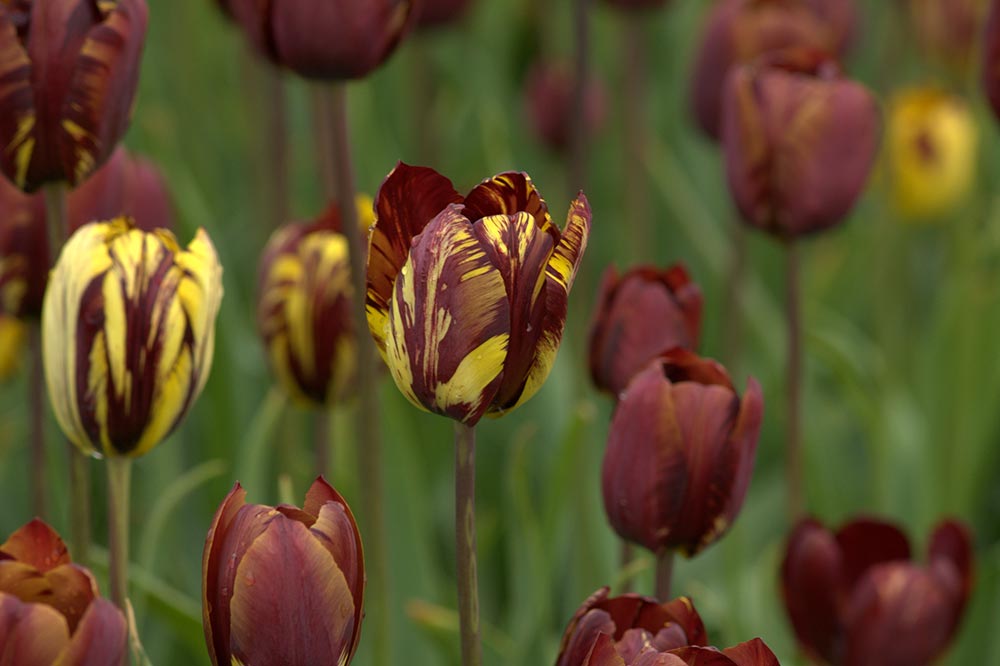
Broken Tulips: The Beautiful Curse

Broken Tulips are like nothing else in the Tulip world. In fact, they are like nothing else in the flower world - their distinct streaks immediately attract the eye and don't let go.
At the height of Tulip Mania, it was the 'broken' flowers that had speculators running wild. Viceroy, Admiraal Van Der Eijk, the legendary Semper Augustus (pictured below) - they all featured the distinct, broken pattern.

But today, these once-legendary breeds no longer exist. And Broken Tulips have fallen out of favor to the point of being illegal in the Netherlands. What happened? With their striking looks, wouldn't the industry want to share these flowers with the masses? Wouldn't they want to be able to offer a piece of the Tulip Mania history?
Unfortunately, the source of this beauty is also a curse. While Tulip Fanatics had long noticed that broken Tulips often seemed smaller and a bit weaker - a trait that actually increased their rarity and desirability during Tulip Mania - it was not until 1928 that scientist Dorothy Cayley discovered the cause to be a Virus.

Spread by aphids, this Tulip Breaking or "Mosaic" virus infects the bulb and causes the flower to 'break' its lock on a single color. This results in the intricate flaring, feathering streaks on the petals. The primary color of the Tulip (its anthocyanin) is suppressed, leaving the underlying white or yellow to show through.
Exact symptoms can vary slightly based on the Tulip, the strain of the virus, and even elements such as time of infection. However, once a bulb is infected, all of its daughter offshoots will be as well.
Over time, the virus weakens the bulb and inhibits proper reproduction. With each new generation, the bulb grows weaker and weaker, until it has no strength left to flower and withers away. It is for this reason that legends of old, like the Semper Augustus, have gone extinct. It is also why many growers today view the breaks not as a benefit but as a danger that must be purged (read more about the dangers posed here).

Fortunately, there is still hope for lovers of these incredible flowers. A few broken breeds, such as the Absalon and Mabel, have somehow remained free of the worst effects of the virus and been able to successfully propagate in perpetuity. Perhaps even more remarkable is the Zomerschoon, a Tulip that has existed since 1620 and witnessed the rise and fall of Tulip Mania (during which it was very popular!). It is unknown exactly why these Tulips have managed to thrive while others have perished, but it likely has something to do with resistant Tulips, a weakened virus, or some combination of both (read more about that here).
While some specialty retailers may sell these old and classic broken breeds, some smaller groups and societies have taken a different approaching - opting to develop and breed new ones. For example, below is an example of a recently bred broken breed - it is so beautiful that the provider requested to remain anonymous for fear that the society to which he belongs would be subjected to a wave of demand (although this person was kind enough to allow us to share the photo!).

If you happen to find these flowers as beautiful as most, and decide to purchase a few for your garden, then be warned that the virus can spread with ease. While some may be excited to see the potential result, others may be displeased to see a well-planned garden come out very differently than expected. Typically, it is recommended to plant broken tulips well away from other flowers, potentially including physical blocks to help prevent the spread of sucking insects like Aphids.
Another option is to look into so called "Modern Rembrandts" - Tulips that, while not broken themselves, have been bred to display multiple colors in streaked, flared patterns. Examples include "Happy Generation", "Prinses Irene", "Flaming Flag", and, pictured below, "Grand Perfection". Many have fallen in love for these flowers just as they would with those pictured above, but others not the subtle differences and, in the end, consider them a pale imitation. In the end, beauty will be in the eye of the beholder, and only you can decide if these work for you, or if you require the real thing :).

Broken Tulip photographs courtesy of Takao Inoue (www.takaoinoue.com), second from final image provided by a small grower society that asked to remain anonymous, final image sourced from Fluwel Flower Bulbs.

